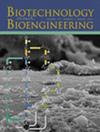A Comprehensive Model for Separating Systematic Bias and Noise in Metabolomic Timecourse Data—A Nonlinear B‐Spline Mixed‐Effects Approach
IF 3.5
2区 生物学
Q2 BIOTECHNOLOGY & APPLIED MICROBIOLOGY
引用次数: 0
Abstract
The simultaneous detection of tens to hundreds of metabolites in a single metabolomic timecourse sample offers a unique but often unrealized opportunity for quantification validation. An individual timecourse fit for each metabolite fundamentally convolutes measurement noise with systematic sample bias (stemming from, for example, variable sample dilution, extraction, and normalization). However, since systematic bias, by its definition, influences all metabolites within a sample in a similar fashion, it can be identified and corrected through the simultaneous fit of all detected metabolites in a single timecourse model. This study presents a nonlinear B‐spline mixed‐effects model as a convenient formulation capable of estimating and correcting such bias. The proposed model was successfully applied to real cell culture data and validated using simulated timecourse data perturbed with varying degrees of random noise and systematic bias. The model was able to accurately correct systematic bias of 3%–10% to within 0.5% on average for typical data. An R package for the correction model has been developed to facilitate model adoption and use. The proposed nonlinear B‐spline mixed‐effects formulation is general enough for application to a broad range of research areas beyond just cell culture metabolomics.代谢组学时间过程数据中分离系统偏差和噪声的综合模型——非线性B样条混合效应方法
在单个代谢组学时间过程样本中同时检测数十到数百种代谢物,为定量验证提供了独特但通常未实现的机会。适合每种代谢物的单独时间过程从根本上将测量噪声与系统样本偏差(例如,源于可变样本稀释、提取和归一化)相结合。然而,由于系统偏差,根据其定义,以类似的方式影响样品中的所有代谢物,可以通过在单个时间过程模型中同时拟合所有检测到的代谢物来识别和纠正。本研究提出了一个非线性B样条混合效应模型,作为一个方便的公式,能够估计和纠正这种偏差。该模型成功地应用于实际细胞培养数据,并通过受不同程度随机噪声和系统偏差干扰的模拟时间过程数据进行了验证。对于典型数据,该模型能够准确地校正3%-10%的系统偏差,平均误差在0.5%以内。为校正模型开发了一个R包,以促进模型的采用和使用。所提出的非线性B样条混合效应公式足以适用于广泛的研究领域,而不仅仅是细胞培养代谢组学。
本文章由计算机程序翻译,如有差异,请以英文原文为准。
求助全文
约1分钟内获得全文
求助全文
来源期刊

Biotechnology and Bioengineering
工程技术-生物工程与应用微生物
CiteScore
7.90
自引率
5.30%
发文量
280
审稿时长
2.1 months
期刊介绍:
Biotechnology & Bioengineering publishes Perspectives, Articles, Reviews, Mini-Reviews, and Communications to the Editor that embrace all aspects of biotechnology. These include:
-Enzyme systems and their applications, including enzyme reactors, purification, and applied aspects of protein engineering
-Animal-cell biotechnology, including media development
-Applied aspects of cellular physiology, metabolism, and energetics
-Biocatalysis and applied enzymology, including enzyme reactors, protein engineering, and nanobiotechnology
-Biothermodynamics
-Biofuels, including biomass and renewable resource engineering
-Biomaterials, including delivery systems and materials for tissue engineering
-Bioprocess engineering, including kinetics and modeling of biological systems, transport phenomena in bioreactors, bioreactor design, monitoring, and control
-Biosensors and instrumentation
-Computational and systems biology, including bioinformatics and genomic/proteomic studies
-Environmental biotechnology, including biofilms, algal systems, and bioremediation
-Metabolic and cellular engineering
-Plant-cell biotechnology
-Spectroscopic and other analytical techniques for biotechnological applications
-Synthetic biology
-Tissue engineering, stem-cell bioengineering, regenerative medicine, gene therapy and delivery systems
The editors will consider papers for publication based on novelty, their immediate or future impact on biotechnological processes, and their contribution to the advancement of biochemical engineering science. Submission of papers dealing with routine aspects of bioprocessing, description of established equipment, and routine applications of established methodologies (e.g., control strategies, modeling, experimental methods) is discouraged. Theoretical papers will be judged based on the novelty of the approach and their potential impact, or on their novel capability to predict and elucidate experimental observations.
 求助内容:
求助内容: 应助结果提醒方式:
应助结果提醒方式:


